

{Shikoku Hachijūhachikasho Meguri}
--PLANNING--
--HOW SHOULD YOU DO IT?--


--PLANNING--
--HOW SHOULD YOU DO IT?--
Now that you've decided to actually do the pilgrimage, the question becomes, how to do it. Do you walk? Do you take a bus? What? There are several options:
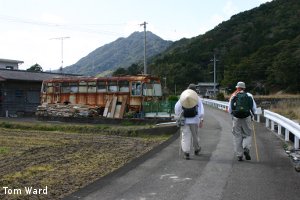 Being a henro is about something in your head - not your legs. The importance of this undertaking, and the implications for the rest of your life, are in your mental attitude and how you approach what you are attempting to do, not in how long it takes and how much you suffer. While walking the pilgrimage i met and talked with henro from each of the above categories, and, without exception, each and every one was serious and devoted to what they had set out to do.
Being a henro is about something in your head - not your legs. The importance of this undertaking, and the implications for the rest of your life, are in your mental attitude and how you approach what you are attempting to do, not in how long it takes and how much you suffer. While walking the pilgrimage i met and talked with henro from each of the above categories, and, without exception, each and every one was serious and devoted to what they had set out to do.
1) Walking
The hardest way to do it, because of the time and money committment required, is probably choosing to walk. Only a very small handful of peoople choose to do the pilgrimage on foot - the rest make the circuit by bus and as members of a group tour. As i have said earlier, if you intend to walk the pilgrimage count on spending somewhere between 40 and 60 days on the road. It can only be done in 40 days if you eliminate the bangai temples and if you really hustle each and every day. But, my understanding is that those who try to do it in this time frame are missing a lot. The trip becomes a challenge to simply get from 1 to 2 to 3 to ... without a chance to see and enjoy the scenery and the people. (Keep in mind that, as you can see to the right, the henro "trail" is usually not a trail.)
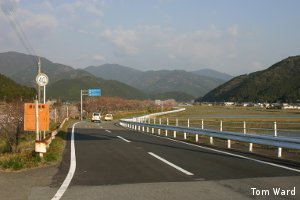
1b) Walking - Begging
Some people have this romantic idea of begging their way around the henro trail, as the first henro must have done centuries ago. I have known of two people who have tried, and i don't think either was successful. One wrote to me and admitted it, the other simply dropped out of sight and never responded to my email enquires, leading me to believe he didn't finish either. In both cases, they wrote to me asking my advice before leaving, and here is how i responded to them and will respond to anyone else who would like to try this option.
Japan, in general, and Shikoku, in particular, does not have the begging tradition. If you restricted your begging to around the train stations in Shikoku's four major cities (Tokushima, Kōchi, Matsuyama, and Takamatsu) you may earn enough to eat every day, but little more. During this walk, however, you spend very little time in large cities and spend the vast majority of your time on the side of the highway in between small towns. If you are really walking throughout the day, you would be expecting people to stop and give you food or money. I do not believe that is going to happen. As i said, they do not have the begging tradition so there is no ingrained habit of stopping to support henro. Yes, there is occasional settai, but this is not enough to support you day in and and day out for more than a month.
My advice, if you are really going to try this, is to make sure you leave enough money with someone, somewhere, for the emergency case of getting you fed and back home if/when you find that you are starving. Also, be sure to print and take the list of free lodging, found on another page of this site, for days when you need to get out of the weather.
Sorry, i wish i could be more positive.
2) Riding a bicycle
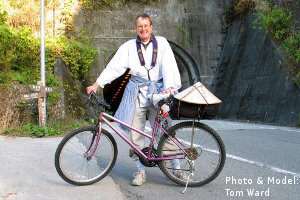 If you just don't have time to walk, another good option is to ride a bicycle. This allows you to cover a lot more territory each day and still allows the time to stop when and where you want throughout the day. Be aware, though, that riding on some of the roads will be a hair pulling experience. I was walking and complained of the roads being too narrow on many occasions. I can't imaging trying to share some of these roads with the trucks while riding a bicycle. But, i have no doubts that those who do the pilgrimage on a bicycle end up having an experience just as memorable as i had.
If you just don't have time to walk, another good option is to ride a bicycle. This allows you to cover a lot more territory each day and still allows the time to stop when and where you want throughout the day. Be aware, though, that riding on some of the roads will be a hair pulling experience. I was walking and complained of the roads being too narrow on many occasions. I can't imaging trying to share some of these roads with the trucks while riding a bicycle. But, i have no doubts that those who do the pilgrimage on a bicycle end up having an experience just as memorable as i had.
For those that want to rent a bicycle instead of bringing their own, as of December 2017, a new business has begun operation in Takamatsu, Kagawa Prefecture. Calling themselves Cycle Shikoku, they rent bikes for both long term and short term rides. More information can be found on their Facebook page.
3) Personal vehicle
A lot of people use their own cars or motorcycles. I have been told that you can visit all of the temples in one prefecture in just two nights and three days if you approach it in this way, which means you can cover all four prefectures in less than two weeks. Not all mountain temples, however, allow you to drive to the top so be prepared to walk up the hill. However, one caveat. "Up the hill" in several cases may mean a two hour walk 'up the hill' to the temple's gate. And, that implies a two hour walk back down. I don't know, but it may be possible to take a cab up the hill in all the cases where the bus stops at the foot of the mountain? I wouldn't be surprised if you could. The pilgrimage has become that user friendly.
4) Public transportation
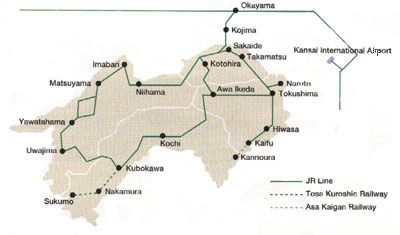 Public transportation is a very good alternative for those with less time. Take the trains from city to city, where they run, and use the local buses to get as close as you can to the temples. Having said that, though, note that the train doesn't go completely around the island. It runs along the entire northern side of the island and 80% of the way down the eastern coast to Cape Muroto. On the western side of the island it continues through Matsuyama City all the way down to Uwajima, but from there it cuts inland and goes straight to Kōchi and then back to Tokushima. Neither Cape Muroto nor Cape Ashizuri have any train services. (See map to right. Click for larger version) For these sections you will need to switch to the bus. I had the impression that most (maybe all) temples had a bus stop either in front of the gate or at the base of the mountain in front of the road heading uphill. As when you drive your own vehicle, however, that may mean you walk the uphill part of the trip. Or, check on taxicabs.
Public transportation is a very good alternative for those with less time. Take the trains from city to city, where they run, and use the local buses to get as close as you can to the temples. Having said that, though, note that the train doesn't go completely around the island. It runs along the entire northern side of the island and 80% of the way down the eastern coast to Cape Muroto. On the western side of the island it continues through Matsuyama City all the way down to Uwajima, but from there it cuts inland and goes straight to Kōchi and then back to Tokushima. Neither Cape Muroto nor Cape Ashizuri have any train services. (See map to right. Click for larger version) For these sections you will need to switch to the bus. I had the impression that most (maybe all) temples had a bus stop either in front of the gate or at the base of the mountain in front of the road heading uphill. As when you drive your own vehicle, however, that may mean you walk the uphill part of the trip. Or, check on taxicabs.
Speaking of taxis, there are many taxi companies that hire out their cabs to henro wanting to do the pilgrimage. For a set fee, a cab and driver are assigned to you and they drive you around the island and to each of the temples. The trip probably (i'm guessing) takes just over a week to complete all four prefectures and all 88 temples.
5) Bus tour
When i walked the pilgrimage i had a serious love-hate relationship with the bus tours (like most other walking henro). Enjoying the atmosphere of a quiet temple and then having that peace shattered when several buses of 40 henro each show up all at the same time can be a nerve shattering experience. I appreciate that many, or most, of the people who join bus tours couldn't make the pilgrimage without this service and throughout my journal i go out of my way to say that completing the pilgrimage on foot does not make you a better henro than someone who completes it by travelling in a bus. Having said that, though, i do believe that there is a major difference between two henro of equal sincerity, one of whom walks and the other who takes the tour. The difference is how they perceive and define what is sacred.
For the walking henro, the entire island is sacred. The pilgrimage starts at the first temple he/she visits and continues uninterrupted for the entire duration of the walk. The walk between temples is just as much a part of the pilgrimage as the stop at each temple itself. In fact, i believe that it is the walk between the temples that constitutes the true heart of the pilgrimage (although i didn't learn that until i was almost finished, and not everyone agrees). For those on a bus tour, however, it seems to me that the pilgrimage is limited to the temples themselves. When the bus arrives at a temple, henro step into their sacred frame of mind, chant the appropriate sutras, offer a prayer, and then get back on the bus. After leaving the temple the pilgrimage is put on hold and life returns to normal until they arrive at the next temple. They are constantly stepping back and forth between the secular and the sacred, each of which is clearly delimited. The time between temples is nothing more than that — between temples — and therefore not particularly significant. While both types of henro can have essentially the same amount of sincerity about what they are doing, and while neither type of henro is inherently better than the other, i see their pilgrimages as fundamentally different.
Numerous guide books list the various companies offering bus tours. Unfortunately these are all in Japanese. One way to find a company is to call one of the main temples (like Ryōzenji or Zentsūji); this may get a phone number for you to call. Of course, if you live in Japan you can simply look in the phone book. However, here is the 2006 schedule and itinerary for the Iyotetsu Bus Company, one of the largest companies offering bus tour packages around the henro trail. If you read Japanese, here is their website with a list of the tours they currently offer.
6) Helicopter tours
7) Proxy tours
8) Virtual tours
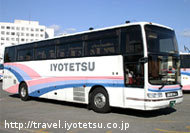 By far, the most common way to do the pilgrimage today is to go by bus. There are many companies that offer all inclusive package tours and the entire pilgrimage can be done this way in about two weeks. For one flat fee of around ¥200,000, the bus company takes care of everything from food and lodging to getting your nōkyō book stamped for you. In addition, the tours are usually led by a priest who will lead the chanting and praying at each temple and another guide that is very knowledgeable about the lore and legends surrounding each temple.
By far, the most common way to do the pilgrimage today is to go by bus. There are many companies that offer all inclusive package tours and the entire pilgrimage can be done this way in about two weeks. For one flat fee of around ¥200,000, the bus company takes care of everything from food and lodging to getting your nōkyō book stamped for you. In addition, the tours are usually led by a priest who will lead the chanting and praying at each temple and another guide that is very knowledgeable about the lore and legends surrounding each temple.
In mid-1998 helicopter tours were added to the list of options. At least one company now charters helicopters for those seriously short on time or physical ability and wanting to do a "flying pilgrimage." A pilgrimage done in this manner takes four days and henro are flown to all but twenty-one of the temples. When they arrive, the helicopter hovers over the temple complex long enough for henro to chant and pray. The remaining twenty-one temples are located in urban areas and tour operators deemed the helicopters unsafe in these areas. Therefore, for these temples henro are shuttled around in vans and buses. (Example itinerary)
For those whose money or physical constraints are critical, the proxy pilgrimage has arrived. In late 2003 i read a newspaper article that for the first time mentioned the option of proxy tours, i.e., hiring someone else to make the pilgrimage on your behalf. For a fee, a proxy agent will go around the pilgrimage route, say the appropriate prayers and chant the appropriate sutras at each of the Hondō and Daishidō, and collect all of the temple stamps - all the while making sure that the gods, buddhas, bodhisattvas, and Daishi-sama know that all of the merit should go to your spiritual bank account. The fee for this service depends on how you want the stamps collected, on an oizuru, a scroll, or in the typical stamp book. It seems that they will only offer to do the pilgrimage by car - no walking proxies were mentioned.
Finally, if you just absolutely can not come up with the time and or money to do the pilgrimage, but somehow feel that it must be done, Pin Change Co. (a subsidiary of Matsushita Electric Industrial Co.) is now selling the "Ohenro-san Game." For this pilgrimage you don't even need to leave your house; scenes of the 88 temples roll by on a television screen as you walk on a treadmill or push the buttons on a Nintendo GameCube console. According to the newspaper article i read, since its launch, it has sold about 3,000 sets, mainly to people aged over 50, and the basic set costs ¥12,800.
Return